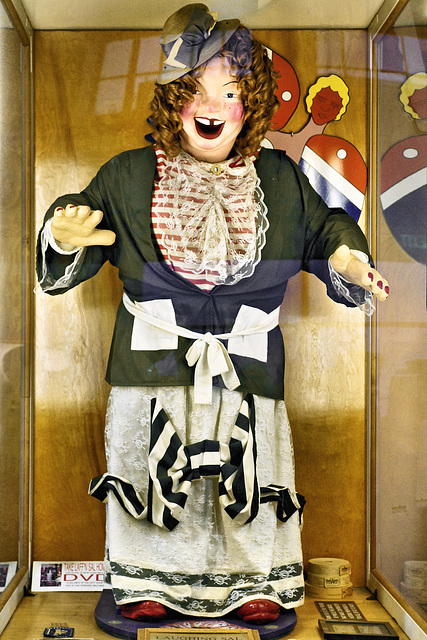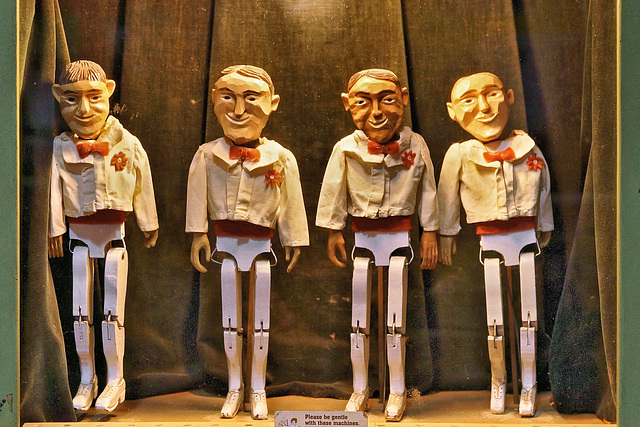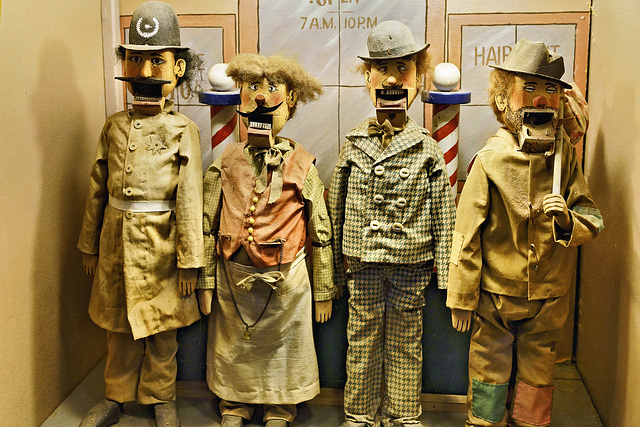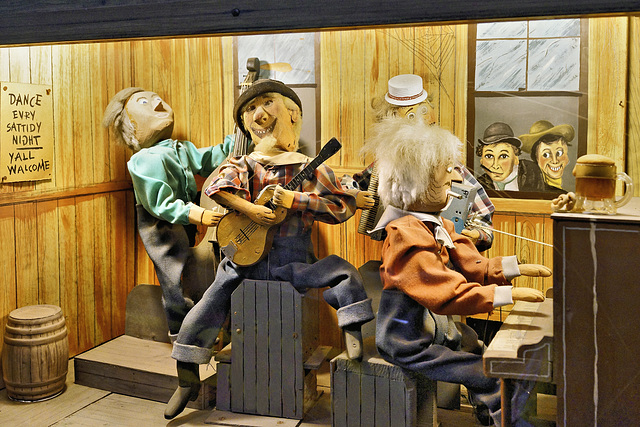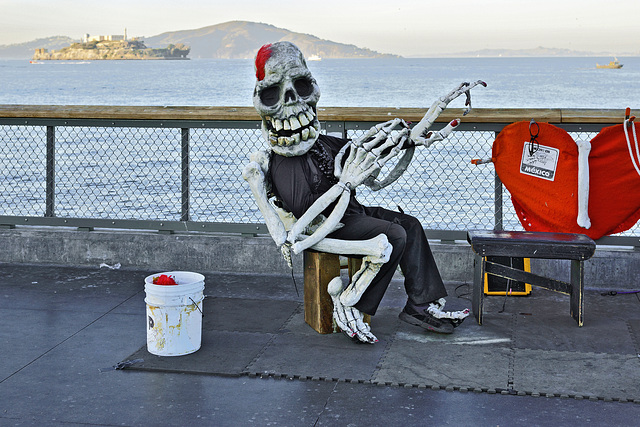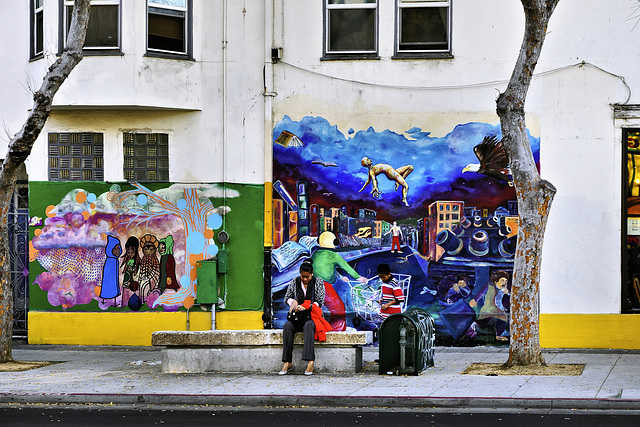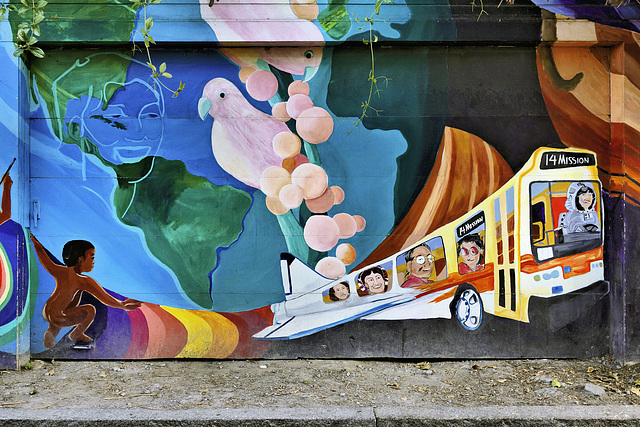
2013
"Laffing Sal" – Musée Méchanique, Pier 45, Fisherman’s Warf, San Francisco, California
Laffing Sal is one of several automated characters that were built primarily to attract carnival and amusement park patrons to funhouses and dark rides throughout the United States. Its movements were accompanied by a raucous laugh that sometimes frightened small children and annoyed adults.
Laffing Sal stands 6 feet, 10 inches high, including a 12-inch pedestal. She is made of papier mache, consisting of seven layers of pressed card stock with horse-hair strengthener, mounted over steel coils and frame. She wears an artificial wig and has a large gap between her front teeth. Her head, arms, hands and legs are detachable and are held together with fabric, staples, pins, nails, nuts and bolts. When activated, she waves its arms and rocks foreward and backward. A record player concealed in its pedestal a recording of a woman laughing hysterically.
All this for only 50¢!
"The Thimble Theatre" – Musée Méchanique, Pier 45, Fisherman’s Warf, San Francisco, California
They dance -- what else is there to know?
The Musée Méchanique is one of the world’s largest privately owned collections of mechanically operated musical instruments and antique arcade machines. Located at Fisherman’s Wharf in San Francisco, California, it consists of some 300 early 20th-century penny arcade games and artifacts including: music boxes, coin-operated fortune tellers, Mutoscopes, video games, love testers, player pianos, peep shows, photo booths, dioramas and animatronic machines. The machines require constant maintenance, with some having undergone major restorations. The collection is a for-profit interactive museum: While admission is free, visitors must pay for the use of each game. More than 100,000 visitors a year do just that.
The Barber Shop "Quart" – Musée Méchanique, Pier 45, Fisherman’s Warf, San Francisco, California
So what if their harmonies are somewhat wooden!
The Musée Méchanique is one of the world’s largest privately owned collections of mechanically operated musical instruments and antique arcade machines. Located at Fisherman’s Wharf in San Francisco, California, it consists of some 300 early 20th-century penny arcade games and artifacts including: music boxes, coin-operated fortune tellers, Mutoscopes, video games, love testers, player pianos, peep shows, photo booths, dioramas and animatronic machines. The machines require constant maintenance, with some having undergone major restorations. The collection is a for-profit interactive museum: While admission is free, visitors must pay for the use of each game. More than 100,000 visitors a year do just that.
"The Ole Barn Dance ... Music by the 'Mountin' Boys" – Musée Méchanique, Pier 45, Fisherman’s Warf, San Francisco, California
The Musée Méchanique is one of the world’s largest privately owned collections of mechanically operated musical instruments and antique arcade machines. Located at Fisherman’s Wharf in San Francisco, California, it consists of some 300 early 20th-century penny arcade games and artifacts including: music boxes, coin-operated fortune tellers, Mutoscopes, video games, love testers, player pianos, peep shows, photo booths, dioramas and animatronic machines. The machines require constant maintenance, with some having undergone major restorations. The collection is a for-profit interactive museum: While admission is free, visitors must pay for the use of each game. More than 100,000 visitors a year do just that.
Death Becomes Him – Fisherman’s Warf, San Francisco, California
Hecho in México ... and with Alcatraz in the background.
Bus Stop – Folsom Street at 24th Street, Mission District, San Francisco, California
The Number 14 Bus Blasting Off – Balmy Alley, Mission District, San Francisco, California
It has been said that the best way to view the murals of the Mission is through the windshield of the number 14 bus. Indeed, MUNI’s line 14 carries over 36,000 passengers on its daily runs through the Mission District. In this mural, native children and tropical landscapes juxtapose a rocket-propelled city bus. This mural was a community effort created as part of a Precita Eyes workshop, designed and painted by Elba Rivera, Barbara Devaney, Laura Smith, Keith Lewis, David Isaacson, and Oscar H. Directed by Susan Cervantes and 2 kids Georgina and Jr.
Manjushri – Balmy Alley, Mission District, San Francisco, California
In Buddhism, a bodhisattva is an enlightened (bodhi) being (sattva). Traditionally, a bodhisattva is anyone who, motivated by great compassion, has experienced a spontaneous wish to attain Buddhahood for the benefit of all sentient beings. In Mahayana Buddhism, Manjushri is a bodhisattva associated with transcendent wisdom. In Esoteric Buddhism he is also taken as a meditational deity. The Sanskrit name Manjushri can be translated as "Gentle Glory", "Soft Glory" , "Wondrous Auspiciousness."
In the mural Manjushri reaches his hand out in a mudra gesture, symbolizing assistance to others. His other hand holds a lotus flower, a symbol of purification and his sword cuts through ignorance.The mural merges iconic images from 17th century Tibetan Art with elements borrowed from Latin American art. It is dedicated to the Dalai Lama.
Marta Ayala is a Latin American woman artist specializing in public murals and paintings. A native of El Salvador, Marta has been a resident of San Francisco since 1968. Her work combines colorful and vibrant images and forms evoking memories from her childhood, ancient cultures and above all, rocks, stones and water. In a sense, Ayala’s work falls into the mainsteam of American art. Her cultural heritage is evident in her primitive approach. In a statement to [me], Marta Ayala sums up her philosophy: "My vision is called primitive because the vivid colors and naive representations call forth ancient emotions. They are a vibrant and powerful affirmation of life."
500 Years of Native Survival – Balmy Alley, Mission District, San Francisco, California
The Mujeres Muralistas was a group of Chicana/Latina artists in the Mission District who pioneered large-scale, woman-painted outdoor murals. In the words of Patricia Rodriguez: "One big motivation for us was recognizing that there had been no successful women muralists in the Mexican mural movement. We wanted to show that women could also paint large outdoor murals. Another factor was the lack of support from the men painting murals in the Mission District who were also critical of the subjects we wanted to paint. We knew that because we were not harassed by police like the men were, and because we had not suffered by having fought in Vietnam, we had a different visual story to tell. We had the freedom to paint whatever we wanted, and we chose the beauty of women and their Mexican and Latino cultures."
As Muralista Irene Perez put it, "We brought fine art to the streets and added the beauty of women in our culture." The mural celebrating 500 years of Indian resistance was painted in 1992 by Perez. The mural makes reference to Coyolxauhqui – the Aztec Goddess of the Moon.
Jump to top
RSS feed- Latest items - Subscribe to the latest items added to this album
- ipernity © 2007-2024
- Help & Contact
|
Club news
|
About ipernity
|
History |
ipernity Club & Prices |
Guide of good conduct
Donate | Group guidelines | Privacy policy | Terms of use | Statutes | In memoria -
Facebook
Twitter

